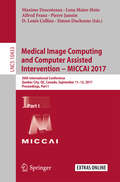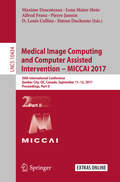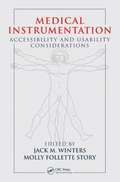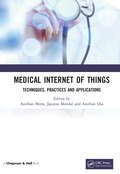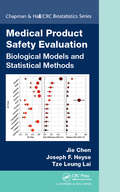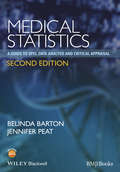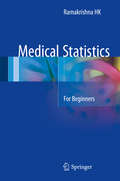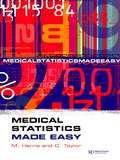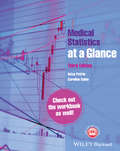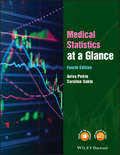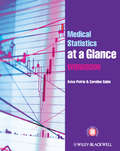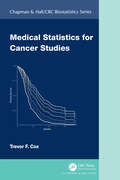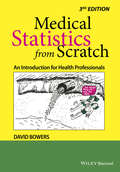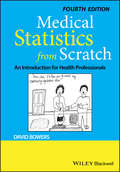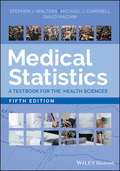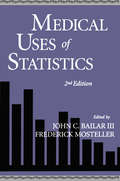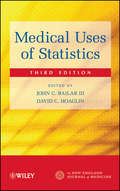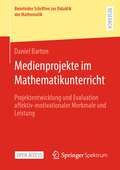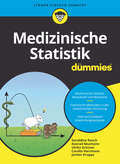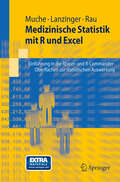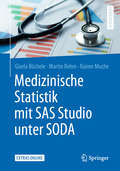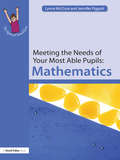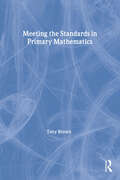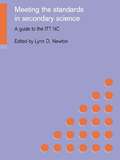- Table View
- List View
Medical Image Computing and Computer Assisted Intervention − MICCAI 2017: 20th International Conference, Quebec City, QC, Canada, September 11-13, 2017, Proceedings, Part I (Lecture Notes in Computer Science #10433)
by Pierre Jannin Maxime Descoteaux Lena Maier-Hein Alfred Franz D. Louis Collins Simon DuchesneThe three-volume set LNCS 10433, 10434, and 10435 constitutes the refereed proceedings of the 20th International Conference on Medical Image Computing and Computer-Assisted Intervention, MICCAI 2017, held in Quebec City, Canada, in September 2017. The 255 revised full papers presented were carefully reviewed and selected from 800 submissions in a two-phase review process. The papers have been organized in the following topical sections: Part I: atlas and surface-based techniques; shape and patch-based techniques; registration techniques, functional imaging, connectivity, and brain parcellation; diffusion magnetic resonance imaging (dMRI) and tensor/fiber processing; and image segmentation and modelling. Part II: optical imaging; airway and vessel analysis; motion and cardiac analysis; tumor processing; planning and simulation for medical interventions; interventional imaging and navigation; and medical image computing. Part III: feature extraction and classification techniques; and machine learning in medical image computing.
Medical Image Computing and Computer-Assisted Intervention − MICCAI 2017: 20th International Conference, Quebec City, QC, Canada, September 11-13, 2017, Proceedings, Part II (Lecture Notes in Computer Science #10434)
by Pierre Jannin Maxime Descoteaux Lena Maier-Hein Alfred Franz D. Louis Collins Simon DuchesneThe three-volume set LNCS 10433, 10434, and 10435 constitutes the refereed proceedings of the 20th International Conference on Medical Image Computing and Computer-Assisted Intervention, MICCAI 2017, held in Quebec City, Canada, in September 2017. The 255 revised full papers presented were carefully reviewed and selected from 800 submissions in a two-phase review process. The papers have been organized in the following topical sections: Part I: atlas and surface-based techniques; shape and patch-based techniques; registration techniques, functional imaging, connectivity, and brain parcellation; diffusion magnetic resonance imaging (dMRI) and tensor/fiber processing; and image segmentation and modelling. Part II: optical imaging; airway and vessel analysis; motion and cardiac analysis; tumor processing; planning and simulation for medical interventions; interventional imaging and navigation; and medical image computing. Part III: feature extraction and classification techniques; and machine learning in medical image computing.
Medical Instrumentation Accessibility and Usability Considerations
by Jack M. Winters Molly Follette StoryIntegrating expert perspectives from a wide array of disciplines, Medical Instrumentation traces a clear roadmap for improving accessibility and usability for a variety of stakeholders and provides the tools necessary to follow it.
Medical Internet of Things: Techniques, Practices and Applications
by Anirban MitraIn recent years, the Medical Internet of Things (MIoT) has emerged as one of the most helpful technological gifts to mankind. With the incredible development in data science, big data technologies, IoT and embedded systems, it is now possible to collect a huge amount of sensitive and personal data, compile it and store it through cloud or edge computing techniques. However, important concerns remain about security and privacy, the preservation of sensitive and personal data, and the efficient transfer, storage and processing of MIoT-based data. Medical Internet of Things: Techniques, Practices and Applications is an attempt to explore new ideas and novel techniques in the area of MIoT. The book is composed of fifteen chapters discussing basic concepts, issues, challenges, case studies and applications in MIoT. This book offers novel advances and applications of MIoT in a precise and clear manner to the research community to achieve in-depth knowledge in the field. This book will help those interested in the field as well as researchers to gain insight into different concepts and their importance in multifaceted applications of real life. This has been done to make the book more flexible and to stimulate further interest in the topic. Features: A systematic overview of concepts in Medical Internet of Things (MIoT) is included. Recent research and some pointers on future advancements in MIoT are discussed. Examples and case studies are included. It is written in an easy-to-understand style with the help of numerous figures and datasets. This book serves as a reference book for scientific investigators who are interested in working on MIoT, as well as researchers developing methodology in this field. It may also be used as a textbook for postgraduate-level courses in computer science or information technology.
Medical Product Safety Evaluation: Biological Models and Statistical Methods (Chapman & Hall/CRC Biostatistics Series)
by Tze Leung Lai Jie Chen Joseph HeyseMedical Product Safety Evaluation: Biological Models and Statistical Methods presents cutting-edge biological models and statistical methods that are tailored to specific objectives and data types for safety analysis and benefit-risk assessment. Some frequently encountered issues and challenges in the design and analysis of safety studies are discussed with illustrative applications and examples. <P><P>Medical Product Safety Evaluation: Biological Models and Statistical Methods presents cutting-edge biological models and statistical methods that are tailored to specific objectives and data types for safety analysis and benefit-risk assessment. Some frequently encountered issues and challenges in the design and analysis of safety studies are discussed with illustrative applications and examples. <P><P>The book is designed not only for biopharmaceutical professionals, such as statisticians, safety specialists, pharmacovigilance experts, and pharmacoepidemiologists, who can use the book as self-learning materials or in short courses or training programs, but also for graduate students in statistics and biomedical data science for a one-semester course. Each chapter provides supplements and problems as more readings and exercises.
Medical Risk Prediction Models: With Ties to Machine Learning (Chapman & Hall/CRC Biostatistics Series)
by Thomas A. Gerds Michael W. KattanMedical Risk Prediction Models: With Ties to Machine Learning is a hands-on book for clinicians, epidemiologists, and professional statisticians who need to make or evaluate a statistical prediction model based on data. The subject of the book is the patient’s individualized probability of a medical event within a given time horizon. Gerds and Kattan describe the mathematical details of making and evaluating a statistical prediction model in a highly pedagogical manner while avoiding mathematical notation. Read this book when you are in doubt about whether a Cox regression model predicts better than a random survival forest. Features: All you need to know to correctly make an online risk calculator from scratch Discrimination, calibration, and predictive performance with censored data and competing risks R-code and illustrative examples Interpretation of prediction performance via benchmarks Comparison and combination of rival modeling strategies via cross-validation Thomas A. Gerds is a professor at the Biostatistics Unit at the University of Copenhagen and is affiliated with the Danish Heart Foundation. He is the author of several R-packages on CRAN and has taught statistics courses to non-statisticians for many years. Michael W. Kattan is a highly cited author and Chair of the Department of Quantitative Health Sciences at Cleveland Clinic. He is a Fellow of the American Statistical Association and has received two awards from the Society for Medical Decision Making: the Eugene L. Saenger Award for Distinguished Service, and the John M. Eisenberg Award for Practical Application of Medical Decision-Making Research.
Medical Statistics
by Belinda Barton Jennifer PeatMedical Statistics provides the necessary statistical tools to enable researchers to undertake and understand evidence-based clinical research. It is a practical guide to conducting statistical research and interpreting statistics in the context of how the participants were recruited, how the study was designed, what types of variables were used, what effect size was found, and what the P values mean. It guides researchers through the process of selecting the correct statistics and show how to best report results for presentation and publication. Clear and concise explanations, combined with plenty of examples and tabulated explanations are based on the authors' popular medical statistics courses. The table of contents is divided into sections according to whether data are continuous or categorical in nature as this distinction is fundamental to selecting the correct statistics. Each chapter provides a clear step-by-step guide to each statistical test with practical instructions on how to generate and interpret the numbers, and present the results as scientific tables or graphs. The chapters conclude with critical appraisal guidelines to help researchers review the reporting of results from each type of statistical test. This new edition includes a new chapter on repeated measures and mixed models and a helpful glossary of terms provides an easy reference that applies to all chapters.
Medical Statistics
by Ramakrishna HkThis book deals with statistics in medicine in a simple way. The text is supported by abundant examples from medical data. This book aims to explain and simplify the process of data presentation. Further aspects addressed include how to design and conduct clinical trials, and how to write journal articles.
Medical Statistics Made Easy
by Michael Harris Gordon TaylorIt is not necessary to know how to do a statistical analysis to critically appraise a paper. However, it is necessary to have a grasp of the basics, of whether the right test has been used and how to interpret the resulting figures. Short, readable, and useful, this book provides the essential, basic information without becoming bogged down in the
Medical Statistics at a Glance (At a Glance)
by Aviva Petrie Caroline SabinMedical Statistics at a Glance is a concise and accessible introduction and revision aid for this complex subject. The self-contained chapters explain the underlying concepts of medical statistics and provide a guide to the most commonly used statistical procedures.This new edition of Medical Statistics at a Glance:Presents key facts accompanied by clear and informative tables and diagramsFocuses on illustrative examples which show statistics in action, with an emphasis on the interpretation of computer data analysis rather than complex hand calculationsIncludes extensive cross-referencing, a comprehensive glossary of terms and flow-charts to make it easier to choose appropriate testsNow provides the learning objectives for each chapterIncludes a new chapter on Developing Prognostic ScoresIncludes new or expanded material on study management, multi-centre studies, sequential trials, bias and different methods to remove confounding in observational studies, multiple comparisons, ROC curves and checking assumptions in a logistic regression analysisThe companion website at www.medstatsaag.com contains supplementary material including an extensive reference list and multiple choice questions (MCQs) with interactive answers for self-assessment.Medical Statistics at a Glance will appeal to all medical students, junior doctors and researchers in biomedical and pharmaceutical disciplines.Reviews of the previous editions"The more familiar I have become with this book, the more I appreciate the clear presentation and unthreatening prose. It is now a valuable companion to my formal statistics course."-International Journal of Epidemiology"I heartily recommend it, especially to first years, but it's equally appropriate for an intercalated BSc or Postgraduate research. If statistics give you headaches - buy it. If statistics are all you think about - buy it."-GKT Gazette"...I unreservedly recommend this book to all medical students, especially those that dislike reading reams of text. This is one book that will not sit on your shelf collecting dust once you have graduated and will also function as a reference book."-4th Year Medical Student, Barts and the London Chronicle, Spring 2003
Medical Statistics at a Glance (At a Glance)
by Aviva Petrie Caroline SabinNow in its fourth edition, Medical Statistics at a Glance is a concise and accessible introduction to this complex subject. Itprovides clear instruction on how to apply commonly used statistical procedures in an easy-to-read, comprehensive and relevant volume. This new edition continues to be the ideal introductory manual and reference guide to medical statistics, an invaluable companion for statistics lectures and a very useful revision aid.This new edition of Medical Statistics at a Glance: Offers guidance on the practical application of statistical methods in conducting research and presenting results Explains the underlying concepts of medical statistics and presents the key facts without being unduly mathematical Contains succinct self-contained chapters, each with one or more examples, many of them new, to illustrate the use of the methodology described in the chapter. Now provides templates for critical appraisal, checklists for the reporting of randomized controlled trials and observational studies and references to the EQUATOR guidelines for the presentation of study results for many other types of study Includes extensive cross-referencing, flowcharts to aid the choice of appropriate tests, learning objectives for each chapter, a glossary of terms and a glossary of annotated full computer output relevant to the examples in the text Provides cross-referencing to the multiple choice and structured questions in the companion Medical Statistics at a Glance Workbook Medical Statistics at a Glance is a must-have text for undergraduate and post-graduate medical students, medical researchers and biomedical and pharmaceutical professionals.
Medical Statistics at a Glance Workbook (At A Glance Ser.)
by Aviva Petrie Caroline SabinThis comprehensive workbook contains a variety of self-assessment methods that allow readers to test their statistical knowledge, put it into practice, and apply it in a medical context, while also providing guidance when critically appraising published literature. It is designed to support the best-selling third edition of Medical Statistics at a Glance, to which it is fully cross-referenced, but may be used independently of it.Ideal for medical students, junior doctors, researchers and anyone working in the biomedical and pharmaceutical disciplines who wants to feel more confident in basic medical statistics, the title includes:* Over 80 MCQs, each testing knowledge of a single statistical concept or aspect of study interpretation* 29 structured questions to explore in greater depth several statistical techniques or principles, including the choice of appropriate statistical analyses and the interpretation of study findings* Templates for the appraisal of clinical trials and observational studies, plus full appraisals of two published papers to demonstrate the use of these templates in practice* Detailed step-by-step analyses of two substantial data sets (also available at www.medstatsaag.com) to demonstrate the application of statistical procedures to real-life researchMedical Statistics at a Glance Workbook is the ideal resource to test statistical knowledge and improve analytical and interpretational skills.Additional resources are available at www.medstatsaag.com, including:* Excel datasets to accompany the data analysis section* Downloadable PDFs of two templates for critical appraisal* Links to online further reading* Supplementary MCQs
Medical Statistics for Cancer Studies (Chapman & Hall/CRC Biostatistics Series)
by Trevor F. CoxCancer is a dreaded disease. One in two people will be diagnosed with cancer within their lifetime. Medical Statistics for Cancer Studies shows how cancer data can be analysed in a variety of ways, covering cancer clinical trial data, epidemiological data, biological data, and genetic data. It gives some background in cancer biology and genetics, followed by detailed overviews of survival analysis, clinical trials, regression analysis, epidemiology, meta-analysis, biomarkers, and cancer informatics. It includes lots of examples using real data from the author’s many years of experience working in a cancer clinical trials unit. Features: A broad and accessible overview of statistical methods in cancer research Necessary background in cancer biology and genetics Details of statistical methodology with minimal algebra Many examples using real data from cancer clinical trials Appendix giving statistics revision.
Medical Statistics from Scratch
by David BowersCorrectly understanding and using medical statistics is a key skill for all medical students and health professionals. In an informal and friendly style, Medical Statistics from Scratch provides a practical foundation for everyone whose first interest is probably not medical statistics. Keeping the level of mathematics to a minimum, it clearly illustrates statistical concepts and practice with numerous real world examples and cases drawn from current medical literature. This fully revised and updated third edition includes new material on: missing data, random allocation and concealment of data intra-class correlation coefficient effect modification and interaction diagnostic testing and the ROC curve standardisation Medical Statistics from Scratch is an ideal learning partner for all medical students and health professionals needing an accessible introduction, or a friendly refresher, to the fundamentals of medical statistics.
Medical Statistics from Scratch: An Introduction for Health Professionals
by David BowersCorrectly understanding and using medical statistics is a key skill for all medical students and health professionals.In an informal and friendly style, Medical Statistics from Scratch provides a practical foundation for everyone whose first interest is probably not medical statistics. Keeping the level of mathematics to a minimum, it clearly illustrates statistical concepts and practice with numerous real-world examples and cases drawn from current medical literature. Medical Statistics from Scratch is an ideal learning partner for all medical students and health professionals needing an accessible introduction, or a friendly refresher, to the fundamentals of medical statistics.
Medical Statistics: A Textbook for the Health Sciences
by Michael J. Campbell David Machin Stephen J. WaltersThe 5th edition of this popular introduction to statistics for the medical and health sciences has undergone a significant revision, with several new chapters added and examples refreshed throughout the book. Yet it retains its central philosophy to explain medical statistics with as little technical detail as possible, making it accessible to a wide audience. Helpful multi-choice exercises are included at the end of each chapter, with answers provided at the end of the book. Each analysis technique is carefully explained and the mathematics kept to minimum. Written in a style suitable for statisticians and clinicians alike, this edition features many real and original examples, taken from the authors' combined many years' experience of designing and analysing clinical trials and teaching statistics. Students of the health sciences, such as medicine, nursing, dentistry, physiotherapy, occupational therapy, and radiography should find the book useful, with examples relevant to their disciplines. The aim of training courses in medical statistics pertinent to these areas is not to turn the students into medical statisticians but rather to help them interpret the published scientific literature and appreciate how to design studies and analyse data arising from their own projects. However, the reader who is about to design their own study and collect, analyse and report on their own data will benefit from a clearly written book on the subject which provides practical guidance to such issues. The practical guidance provided by this book will be of use to professionals working in and/or managing clinical trials, in academic, public health, government and industry settings, particularly medical statisticians, clinicians, trial co-ordinators. Its practical approach will appeal to applied statisticians and biomedical researchers, in particular those in the biopharmaceutical industry, medical and public health organisations.
Medical Uses of Statistics
by Frederick Mosteller John C. Bailar IiiThis work explains the purpose of statistical methods in medical studies and analyzes the statistical techniques used by clinical investigators, with special emphasis on studies published in "The New England Journal of Medicine". It clarifies fundamental concepts of statistical design and analysis, and facilitates the understanding of research results.
Medical Uses of Statistics, 3rd Edition
by David C. Hoaglin John C. BailarA new edition of the classic guide to the use of statistics in medicine, featuring examples from articles in the New England Journal of Medicine Medical Uses of Statistics has served as one of the most influential works on the subject for physicians, physicians-in-training, and a myriad of healthcare experts who need a clear idea of the proper application of statistical techniques in clinical studies as well as the implications of their interpretation for clinical practice. This Third Edition maintains the focus on the critical ideas, rather than the mechanics, to give practitioners and students the resources they need to understand the statistical methods they encounter in modern medical literature. Bringing together contributions from more than two dozen distinguished statisticians and medical doctors, this volume stresses the underlying concepts in areas such as randomized trials, survival analysis, genetics, linear regression, meta-analysis, and risk analysis. The Third Edition includes: Numerous examples based on studies taken directly from the pages of the New England Journal of Medicine Two added chapters on statistics in genetics Two new chapters on the application of statistical methods to studies in epidemiology New chapters on analyses of randomized trials, linear regression, categorical data analysis, meta-analysis, subgroup analyses, and risk analysis Updated chapters on statistical thinking, crossover designs, p-values, survival analysis, and reporting research results A focus on helping readers to critically interpret published results of clinical research Medical Uses of Statistics, Third Edition is a valuable resource for researchers and physicians working in any health-related field. It is also an excellent supplemental book for courses on medicine, biostatistics, and clinical research at the upper-undergraduate and graduate levels. You can also visit the New England Journal of Medicine website for related information.
Medienprojekte im Mathematikunterricht: Projektentwicklung und Evaluation affektiv-motivationaler Merkmale und Leistung (Bielefelder Schriften zur Didaktik der Mathematik #13)
by Daniel BartonDaniel Barton entwickelt auf Grundlage theoretischer Rahmenmodelle hinsichtlich emotionaler und motivationaler Faktoren von Lernprozessen ein Unterrichtsprojekt im Rahmen des Mathematikunterrichts der Sekundarstufe I. In dieser Lernumgebung produzieren Schülerinnen und Schüler der neunten Jahrgangsstufe des Gymnasiums Erklärvideos zu geometrischen Körpern. In einer umfassenden Studie untersucht der Autor den Einfluss der Lernumgebung auf emotionale und motivationale Faktoren sowie die Lernentwicklung in diesem mathematischen Themengebiet. Die Befunde weisen auf eine erhöhtes intrinsische Motivation innerhalb dieser Lernumgebung sowie positive Auswirkungen auf das emotionale Erleben im Mathematikunterricht hin.Dies ist ein Open-Access-Buch.
Medizinische Statistik für Dummies (Für Dummies)
by Geraldine Rauch Jochen Kruppa Ulrike Grittner Konrad NeumannWenn auch Sie Ihre kleinen Problemchen mit medizinischer Statistik haben, sind Sie hier genau richtig. Mit viel Witz bringen Ihnen die Autoren Geraldine Rauch, Konrad Neumann, Ulrike Grittner, Carolin Herrmann und Jochen Kruppa die Prinzipien der Biostatistik näher. In diesem Buch lernen Sie alles, was Sie benötigen, um Statistik im medizinischen Bereich erfolgreich einzusetzen. Angefangen bei der Begriffskunde und den Grundlagen, erfahren Sie alles von Studientypen über deskriptive Verfahren, Verteilungen, Schätzungen oder Korrelation und Regression bis hin zur Ereigniszeitanalyse, diagnostischen Tests und multiplem Testen. Die Autoren bringen Ihnen das theoretisch vermittelte Wissen mit vielen anschaulichen Beispielen näher. So schaffen Sie die nächste Klausur mit Links!
Medizinische Statistik mit R und Excel
by Rainer Muche Michael Rau Stefanie LanzingerVielfach genutzt für die Verarbeitung von Daten in Tabellenform, war Excel bisher für statistische Analysen weniger geeignet. Seit 2009 kann mit dem Add-In RExcel die Statistiksoftware R eingebunden werden. Der Band bietet die erste Einführung auf Deutsch zur Benutzung der RExcel-Oberfläche. Anhand eines Beispieldatensatzes aus der Herz-Kreislaufforschung werden Deskriptive Statistik, Korrelation und Regression, statistische Tests, Überlebenszeitanalyse sowie Fallzahlplanung nachvollziehbar dargestellt. Mit Schritt-für Schritt-Anleitungen und Tipps.
Medizinische Statistik mit SAS Studio unter SODA
by Rainer Muche Gisela Büchele Martin RehmStatistische Auswertung - selbst gemacht!Der in dem vorliegenden Buch beschriebene Zugang über SAS® OnDemand for Academics (SODA) erlaubt einen kostenfreien, browser-basierten Zugang zur SAS-Software. Dabei können unter SAS Studio in einer menügesteuerten Oberfläche statistische Auswertungen ausgeführt werden. Die Oberfläche ist auch in einer deutschsprachigen Version verfügbar.Das Buch wurde so konzipiert, dass es sich hervorragend zum Selbststudium eignet. Zu Beginn wird eine Einführung in die Benutzung der SAS Studio Oberfläche gegeben. Anhand eines Beispieldatensatzes werden deskriptive Statistik, Korrelation/Regression, statistische Tests, Überlebenszeitanalyse sowie Fallzahlplanung mit zahlreichen Screen-Shots nachvollziehbar dargestellt. Eine Anleitung zur kostenlosen Registrierung von SAS-SODA ist ebenfalls enthalten. Darüber hinaus werden praktische Tipps zur Nutzung und Datenaufbereitung gegeben.So können Sie Ihre statistische Auswertung sicher und schnell selbst erledigen.Die AutorenDr. Gisela Büchele und Martin Rehm sind wissenschaftliche Mitarbeiter am Institut für Epidemiologie und Medizinische Biometrie, Ulm.Prof. Dr. Rainer Muche ist stellvertretender Institutsdirektor des Instituts für Epidemiologie und Medizinische Biometrie, Ulm.
Meeting the Needs of Your Most Able Pupils: Mathematics (The Gifted and Talented Series)
by Lynne McClure Jennifer PiggottMeeting the Needs of Your Most Able Pupils: Mathematics provides specific guidance on: recognising high ability and potential planning, differentiation, extension and enrichment in Mathematicss teacher questioning skills support for more able pupils with special educational needs (dyslexia, ADHD, sensory impairment) homework recording and assessment beyond the classroom: visits, competitions, summer schools, masterclasses, links with universities, businesses and other organisations. The book includes comprehensive appendices with linked resources available online that feature: lesson plans and examples of activities departmental procedures and action plans identification strategies guidance on auditing provision for more able pupils. This book is an essential resource for secondary teachers, subject heads of departments, leading teachers for G&T Education (gifted and talented co-ordinators), SENCos and LA advisers.
Meeting the Standards in Primary Mathematics: A Guide to the ITT NC
by Tony BrownThis book guides readers through the professional standards and requirements to reach Qualified Teacher Status, explaining what trainees need to know. The author discusses the best ways of developing mathematical knowledge and teaching skills, and how to acquire the professional know-how needed to complete the training successfully.will: help readers to understand the Standards related to mathematics teaching offer detailed guidance on the primary mathematics curriculum help readers prepare for the QTS skills test help readers to develop the pedagogical knowledge that you need for effective teaching of mathematics help readers prepare for school-based training provide ideas, suggestions and further reading to support during their training and their NQT year. This practical guide to meeting the standards is invaluable for students on primary training courses, lecturers and mentors supporting trainees in mathematics education programmes and newly qualified teachers.
Meeting the Standards in Secondary Science: A Guide to the ITT NC
by Lynn D. NewtonThis practical, comprehensive and accessible book will prove invaluable for students on secondary initial teacher training courses, PGCE students, lecturers on science education programmes and newly qualified secondary teachers.It provides: the pedagogical knowledge needed to teach science in secondary schools support activities for work in schools and self-study information on professional development for secondary teachers.
